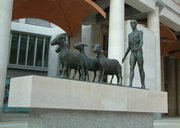Paternoster Square
|
|
Paternoster_Square.jpg
St_Paul's_Cathedral_dome_from_Paternoster_Square_-_London_-_240404.jpg
Paternoster Square is an urban development north of St Paul's Cathedral in the City of London.
In 1942, the area, which takes its name from Paternoster Row — a street down which the monks of the medieval St Pauls would walk, chanting the Lord's Prayer (Pater Noster being its opening lines in Latin) — was devastated by aerial bombardment in The Blitz. From 1961-1967 the entire superblock between St Pauls churchyard and Newgate street was redeveloped according to a scheme by William Holford. The new Paternoster Square soon became immensely unpopular, its grim (in the eyes of many) presence immediately north of one of the capital's prime tourist attractions an embarrassment.
In the late 1980s, as it became harder and harder to fill leases on the site, proposals to redevelop the area were brought forward. An initial competition was won in 1987 by Arup associates with a complicated (some said incoherent) postmodern plan. This was in turn abandoned in 1990 in favour of John Simpson's classicizing scheme, initially sponsored by a newspaper competition and championed by the Prince of Wales. Criticized by many as a bizarre pastiche, this plan too was abandoned.
Paternoster.square.column.arp.500pix.jpg
In 1996 a masterplan by William Whitfield was adopted and put into action over the following years. By October 2003 the redeveloped Paternoster square was complete, with buildings by Whitfield's firm and several others. Among the main tenants was the newly relocated London Stock Exchange.
Supporters of the scheme praised it for its harmonious architecture, much of it built in brick and stone like Wren's chapter house for St Pauls (which is integrated into the plan); for its mix of offices and shops; and for its coherent organization of space by means of a large central piazza and urban walkways which cut through the superblock in logical ways to tie it into the surrounding urban fabric and address St Pauls directly; and claimed that it represented an ideal example of modern development on a traditional site.
Critics called the architecture banal; dismissed the mixed-use credentials of any development which incorporated no housing (on weekends outside peak tourist season, they warned, the pedestrian zone would be dead, its shops and restaurants empty); denied that, consisting as it did mainly of a few large office blocks, it represented any sort of new departure in urban planning; and pondered what really makes a good neighbour: was it possible, they speculated, that the old bleak Paternoster square of the 1960s, universally accounted an eyesore, was actually a better neighbour to St Paul's by contrasting with it than the new, ambitious development which aped it unconvincingly?

Monuments and sculpture
The most obvious monument in the redeveloped square is the 23m tall Paternoster Square Column. It is a Corinthian column of Portland stone topped by a gold leaf covered flaming copper urn, which is illuminated by fibre-optic lighting at night. The column was designed by the architects Whitfield Partners.
At the north end of the square is the bronze Shepherd and Sheep by Dame Elizabeth Frink. The statue was commissioned for the previous Paternoster Square complex in 1975 and was replaced on a new plinth following the redevelopment.
See also
External links
- Paternoster Square (http://www.paternosterlondon.co.uk/) official website
- CWO (http://www.cwo.uk.com/projects/paternoster_column.html) construction of Paternoster Column
